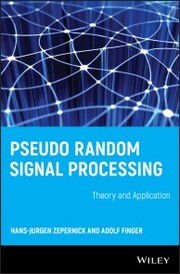-
Zusatztext
-
In recent years, pseudo random signal processing has proven to be a critical enabler of modern communication, information, security and measurement systems. The signals pseudo random, noise-like properties make it vitally important as a tool for protecting against interference, alleviating multipath propagation and allowing the potential of sharing bandwidth with other users.<p>Taking a practical approach to the topic, this text provides a comprehensive and systematic guide to understanding and using pseudo random signals. Covering theoretical principles, design methodologies and applications,<i>Pseudo Random Signal Processing: Theory and Application</i>:</p><ul><li>sets out the mathematical foundations needed to implement powerful pseudo random signal processing techniques;</li><li>presents information about binary and nonbinary pseudo random sequence generation and design objectives;</li><li>examines the creation of system architectures, including those with microprocessors, digital signal processors, memory circuits and software suits;</li><li>gives a detailed discussion of sophisticated applications such as spread spectrum communications, ranging and satellite navigation systems, scrambling, system verification, and sensor and optical fibre systems.</li></ul><p><i>Pseudo Random Signal Processing: Theory and Application</i>is an essential introduction to the subject for practising Electronics Engineers and researchers in the fields of mobile communications, satellite navigation, signal analysis, circuit testing, cryptology, watermarking, and measurement. It is also a useful reference for graduate students taking courses in Electronics, Communications and Computer Engineering.</p>
-
-
Kurztext
-
In recent years, pseudo random signal processing has proven to be a critical enabler of modern communication, information, security and measurement systems. The signal s pseudo random, noise-like properties make it vitally important as a tool for protecting against interference, alleviating multipath propagation and allowing the potential of sharing bandwidth with other users. Taking a practical approach to the topic, this text provides a comprehensive and systematic guide to understanding and using pseudo random signals. Covering theoretical principles, design methodologies and applications, Pseudo Random Signal Processing: Theory and Application: sets out the mathematical foundations needed to implement powerful pseudo random signal processing techniques; presents information about binary and nonbinary pseudo random sequence generation and design objectives; examines the creation of system architectures, including those with microprocessors, digital signal processors, memory circuits and software suits; gives a detailed discussion of sophisticated applications such as spread spectrum communications, ranging and satellite navigation systems, scrambling, system verification, and sensor and optical fibre systems. Pseudo Random Signal Processing: Theory and Applicationis an essential introduction to the subject for practising Electronics Engineers and researchers in the fields of mobile communications, satellite navigation, signal analysis, circuit testing, cryptology, watermarking, and measurement. It is also a useful reference for graduate students taking courses in Electronics, Communications and Computer Engineering.
-
-
Autorenportrait
- <p><B>Zepernick, Hans-Jürgen</b> is affiliated to Department Of Creative Technologies, Blekinge Institute of Technology, where Zepernick, Hans-Jürgen is currently working as Professor. Zepernick, Hans-Jürgen has numerous publications within the specialty and published in reputed national and international peer-reviewed journals. Zepernick, Hans-Jürgen is actively associated with different national and international societies and academies. Zepernick, Hans-Jürgen gain recognition among the honourable subject experts with the contributions made. Dr. Zepernick, Hans-Jürgen is been appreciated by several reputed awards and funding support. Dr. Zepernick, Hans-Jürgen major research interest is in studies related to control engineering& cybernetics,Decision Support System.<p><b>Adolf Finger</b> received the Dipl.-Ing. degree (MSc) from Dresden University of Technology, (TUD), Germany, and the Dr.-Ing. degree (PhD) with summa cum laude from the same University, both in electrical engineering. He holds the positions of Professor in Communications Theory, Managing Director of the Communications Laboratory and until 2006 dean of the Department of Electrical Engineering and Information Technology at TUD.Adolf Finger is author and co-author of some 60 technical papers in the areas of communications systems, coding techniques, wireless communications, signal and sequence design. He is author of two textbooks: Digitale Signalstrukturen, Verlag Technik Berlin/R. Oldenbourg München, Wien (1985) Pseudorandom Signalverarbeitung, Teubner Verlag Stuttgart (1997) and co-author (with H.-J. Zepernick) of the book: Pseudo Random Signal Processing, Wiley 2005 and 2007 (China- Edition).
Detailansicht
Pseudo Random Signal Processing
eBook - Theory and Application
ISBN/EAN: 9780470866580
Umbreit-Nr.: 5440386
Sprache:
Englisch
Umfang: 440 S., 15.82 MB
Format in cm:
Einband:
Keine Angabe
Erschienen am 17.07.2013
Auflage: 1/2013
E-Book
Format: PDF
DRM: Adobe DRM


